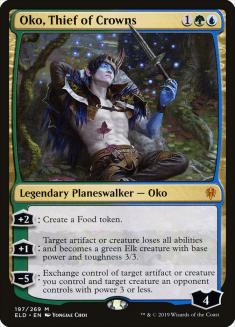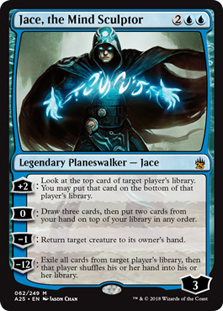Hello and welcome back to Sullivan’s Satchel. I just got back from the Star City Games Players’ Championship, which was awesome on the balance, but I’m currently detoxing from three days of Oko mirrors. My apologies in advance if my energy is more muted than usual. The good news is that there’s a ton of interest in the formats and cards from last weekend, plus a round of Pioneer bannings, so lots of good options to pull from Again, please send your own questions to [email protected].
Tyler asks:
What are your thoughts on Oko? How does something like that go to print? Related: Thoughts on the Pioneer bannings?
Oko is a tough nut to crack, since it seems so far out of bounds and that fact would reveal itself without that many games played. How does Play Design green light something like that? In spite of being the most expensive card in the set, Wizards of the Coast (WotC) decided that they had to ban it in Standard a few months after the set released; it just met the same fate in Pioneer. I’m not optimistic it survives in the long-term in Modern and beyond, either.
To start with, even if Oko grades out as a “F” overall, not every element of the card is indefensible. Some good principles are being adhered to. Specifically, I would point to:
- Food is a new mechanic, and Oko ensures that some Food shows up in Constructed and encourages playing with other cards that generate Food. This isn’t just theory; Gilded Goose, Wicked Wolf, and Trail of Crumbs have shown up alongside Oko, and their power level is connected to Oko’s presence in those decks.
- Oko can make certain games that otherwise wouldn’t be about combat about combat and makes some games that would struggle to end come to a conclusion. I think this one breaks down pretty quickly, as Oko is at its best against people who are trying to attack and block, and within those games it typically makes them take much longer. But it does cut the other way sometimes, and one could argue that Oko has a net-positive impact on a sampling of games that feature few-to-no creatures.
The failings aren’t numerous but they are massive. The big, obvious one: too many cards “interact” with Oko the exact same way. The way that each card that interacts with Oko interacts with one another is also the same. That’s extremely repetitive and boring, and makes the challenge of solving Oko much less interesting.
The other major problem: the loyalty just keeps going up. Combined with the first issue, this means that Oko never ends, and more importantly, there’s often no hope of drawing anything that can change the shape of the game. The draw step is one of the most fun parts of Magic; the hope that you can draw something to change your fortunes is a key element to making the game enjoyable for the player who is losing. To strip that out of the game is one of the most dangerous spaces to indulge in, especially for a card that’s off the rails on rate in the first place and doesn’t cost much mana.
A comparison to Jace, the Mind Sculptor is illuminating. Remember, we’re talking about Jace here, an all-time great and a card notorious for engendering feelings of helplessness. -1 to Unsummon is extremely powerful in context, but it can’t go on forever; eventually either the player with Jace has to lose their Jace or decide to do something else. The +2 mode can be frustrating as well, but if they bottom your card (or you can shuffle your deck, etc.), you still might draw to something that changes the shape of the game. And Jace’s loyalty-to-mana cost is such that it’s vulnerable to a wide array of cards that aren’t Hero’s Downfall: Bloodbraid Elf, Creeping Tar Pit, and many other cards not explicitly meant to kill planeswalkers line up well against Jace.
Oko has a loyalty-to-mana cost ratio that makes something like Boggart Ram-Gang a joke, and the Elk power makes your draw step a source for less optimism than while under Jace, the Mind Sculptor. Combine all the above with a rate past what the ceiling should be and you have all the makings of disaster.
I believe there was a stream involving Play Design members in which they said they underestimated the power of Oko’s +1 as a defensive measure. That is startling to me, since it doesn’t take all that many games against a reasonable distribution of creatures to see how oppressive that element is. Makes me wonder if the Dragons and Angels are getting enough testing, or just bracketed off as unplayable with the focus going to Rampant Growths, Sphinx’s Revelations, planeswalkers, Hero’s Downfalls, and similar classes of cards that are over-represented in competitive play. I guess we’ll see.
As far as Pioneer goes, good riddance to Oko and Nexus of Fate, given my understanding of how they want to manage the Banned List. They both encourage dubious play patterns and incentives, and Oko has to be among the most powerful cards in the format to begin with. Nexus of Fate isn’t exactly Shahrazad, but it can be a logistical nightmare and unlike Shahrazad it’s actually kind of good, so it comes up. Why try to balance the format around these cards?
David wants to know:
What are your favorite games besides Magic?
Depending on how far you want to stretch the definition, basketball is the clear #1, probably even more than Magic. NBA Jam, old Madden/NBA games, and a handful of RPGs stand out as far as video games go. If you want to stay inside the fantasy hobby genre, my first love (a few years before Magic) was Battle Masters.

Some cursory searching suggests this game has become something of a collector’s item, so unfortunately it isn’t an easy game to sample. But the quick synopsis is there is a big vinyl map with two armies, and each player arranges their army on the map. There is a deck of cards with one or more units represented on them; the cards get turned up, and then the units depicted on each card are allowed to move and attack that turn. It’s simple, fun, dramatic, replayable, and at the risk of repeating myself you get to play on a gigantic map. Would highly recommend, setting aside how expensive it has apparently become.
Lastly, from unknown:
What do you think about the future of paper Magic and organized play?
I guess the implication in this sort of question is that paper Magic is being delegitimized, or at least becoming secondary to Arena. It’s hard not to wonder; the resources being poured into Arena and Arena-connected organized play outstrip those going into paper Magic (and Magic Online, which has always had a connection to physical Organized Play.) It is hard to imagine moving backwards on this trend, at least in the near future.
I suppose I remain optimistic that physical play will still be a large part of things almost no matter what, for a few reasons.
- I don’t think Magic is that great of a digital game, and it seems like Arena is committed to fidelity to Magic’s game engine the same way Magic Online was and is. Not to say it can’t be good, and Arena is several steps in the right direction compared to Magic Online, but if you were starting a game engine from scratch to be digital-only there’s no way it would look anything like Magic’s, with tons of clicks, keywords, and opaque rules. I think it is far more likely that someone decides they like paper Magic (or the experience of live play) and then Arena is another product for them to enjoy, rather than a digital consumer going through the pains of learning Magic compared to much simpler competitors, and then deciding to transition to physical play.
- I think physical play is a safeguard against burnout, overconsumption, and of going through phases of just not enjoying the game. Not every player is optimized for a digital experience and physical Magic (with the related social experiences, often with friends) can serve as a jumping-on point for a player who has been out of action for a period of time.
- The margins are pretty absurd. $4 for a pack? People buy a lot of those, too. People also buy a lot of $100 boxes with five dragons with rarity holograms made out of unobtanium or whatever, and those products lose a lot of their luster if physical Magic isn’t supported.
- Part of the appeal of Magic is the history — it has been around for a very long time, which is cool, and the fact that it has been around for a long time implies it will continue to do so, which is not true of the vast majority of games that come out today. People pay whatever money they pay for Juzam Djinn not because of any utility but because it’s cool. A Juzam Djinn on Arena would not be cool. Part of the stickiness of the experience is the feeling that you are engaging with something with historical cachet and paper is the fundamental element of that.
I think there is a conflation going on because the MPL and Arena are tethered together, so that it makes it seem like Arena is coming at the expensive of a broader physical Organized Play system, or something. I think the timing is just convenience — I think Magic has not done enough over the years to build up a stable of stars, that it should have been a goal of Organized Play regardless of the medium, and that Arena just gave them a good time to overhaul things anyway. Maybe they wouldn’t have had the motivation and incentives to do it without Arena, but I think the direction they’re moving in makes sense even if Arena didn’t exist.
I would also caution about being too reactionary to any of these changes in general — Magic’s releases and Organized Play have gone through many changes over the years, and were motivated by circumstances much less extreme than the release of a massive digital initiative. I am sure they are reading and responding to new information as much as they are executing on plans, at least right now. At root, I think that physical cards, and the Organized Play systems that promote them, are too fundamental to Magic’s brand identity and too lucrative to toss aside even if Arena changes the game.


